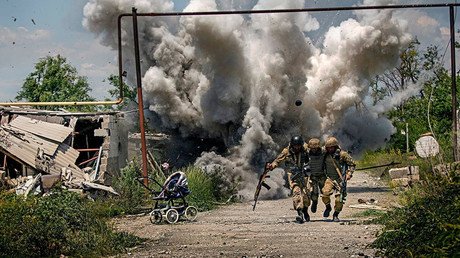Ukrainian troops blast flaws in new ‘Molot’ mortars, manufacturer blames lack of training

Ukrainian troops trying the new domestically-developed 120mm ‘Molot’ mortars have complained of jamming and other flaws. The weapon’s producer has dismissed the criticism, saying the soldiers lack training.
The M-120-15 Molot is Ukraine’s newest mortar launcher. Produced by the Kiev factory Mayak, the design is basically a reworking of the old Soviet 2B11 Sani mortar. The Ukrainian Defense Ministry ordered the development of the Molot when its stockpile of Sani mortars left over from the Soviet era began to run short, with the ministry wanting a domestically-produced model in series.
The process apparently was completed in haste. According to Mayak, it took it only two months to finish the redesign. The new mortar was said to be made of better material and be more reliable than its Soviet predecessor. The specifications provided by the producer were almost identical to those of the prototype, although the Molot’s rate of fire was reduced to 12 rounds per minute compared to the Sani’s 15 rounds per minute.
In June, the first Molots began to arrive in military units for trials, and reports emerged that their performance was discouraging. One example was a mortar battery commander’s report leaked to a popular Ukrainian military news site, which said all six Molots delivered to his unit stationed in the western Rovno region had jammed during trials. The commander also said the mortars were poorly painted and that they were rusting rapidly.
Later in June, an officer was killed and eight other people injured when a mortar exploded at the Shiroky Lan range in the Nikolaev region. The mortar that failed was a Molot. No full report about the incident has been released so far, but several Ukrainian officials have claimed that the problem was with the shell, not the mortar.
“We knew about this mortar since spring and it was said to be an unreliable weapon that constantly fails. That’s why we reacted accordingly when this piece of marvel arrived in our battalion two weeks ago,” one of the soldiers at the range told Strana.ua news website at the time.
The controversy over the Molot escalated last week when Anatoly Tapolsky, a popular Ukrainian blogger currently serving in the army, criticized the mortar after his unit tried it.
“It’s a bad copy of the Sani. The new mortars look shabby, the paint goes off just like that. We tried 12 Molots, and two of them failed – one just broke even before we erected it, another after the first shot,” he wrote on Facebook.
“And another one really hurts. The Molot costs almost half a million [483,000 hryvnias, about $19,000] so I thought ‘OK, they cheated with the metal hiking the cost eight times, but they must have some really good optics. Molots have sights made in 1946! Made in the USSR,” he added.
Facing the criticism, the head of Ukrainian military corporation Ukroboronprom, which includes Mayak, said on Tuesday there was nothing wrong with the mortar.
“A commission established that the 120mm mortar Molot complies with the demands of the 1 category devices, i.e. new devices,” Roman Romanov told 5th television channel.
He said the troops who complained about the Molot’s quality must have used them incorrectly and require proper training. He also rejected the allegations that the weapon was overpriced.
Presidential aide Yury Biryukov said the old sights mentioned by Tapolsky were indeed old Soviet products and that Ukraine simply does not produce such devices domestically. He said revealing and eliminating flaws in a new design is a normal process.
Domestic weapons production is a matter of public relations for the Ukrainian government. For over two decades after gaining independence it relied on old Soviet stockpiles and cooperation with Russia to meet its demand for weapons. After the new anti-Russian government came to power in Kiev it broke most of the ties with Moscow, but failed to secure supplies of weapons from its Western sponsors. Each new domestically produced weapon is reported as a major breakthrough by the Ukrainian military and media.













